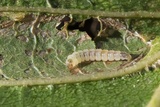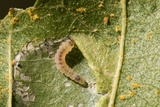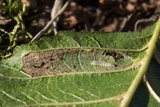Phyllonorycter froelichiella (Zeller, 1839) Species
Last modified: Dec. 14, 2024, 3:52 p.m.
A rather rare species throughout Belgium.
Details
- Classification
- Family: Gracillariidae > Subfamily: Lithocolletinae > Genus: Phyllonorycter > Species: Phyllonorycter froelichiella
- Vernacular names
- Oranje elzenvouwmot (NL), Broad-barred midget (EN), Große Erlen-Faltenminiermotte (DE)
- First mention in Belgium
- De Fré Ch. 1858. Catalogue des Microlépidoptères de la Belgique. — Annales de la Société entomologique belge 2: 45–162. On page 157. view page
- Status
-
Native
Distribution
Imago
Head ochreous to brown; forewing ground colour brown: white pattern consisting of two broad white transverse bands, two white costal and one white dorsal striae, the first ones joined in the middle; basal line absent but sometimes a whitish yellow patch is present, especially at the dorsum.
Museum specimens
No pictures yet!Specimens in nature
No pictures yet!Mine
Very similar to the mine of Ph. klemannella, but the distinction is quite easy: Ph. froelichiella mines extend from a leaf axil between the midrib and a lateral vein. Young mines are situated in a leaf axil and their colour is green like the rest of the leaf. In a later stage, the mine discolours to a rust-red shade, while the rest of the leaf remains green. Ph. klemannella mines never reach into a leaf axil, on the contrary, they sometimes are situated much closer to the midrib. The are no clear longitudinal folds. The black frass is concentrated in a corner of the mine.
See also gracillariidae.net and bladmineerders.be.
Cocoon/pupa
In contrast to Ph. klemannella, the cocoon is more or less constructed in the center of the long mine, whitish till light brown. Pupa orange to light brownish.
Bionomics
The larva makes a very long mine between two veins on the underside of a leaf. Often several mines together on one leaf, always between veins and extending from the midrib almost to the leaf margin. The cocoon is fastened to the roof of the mine. Pupation inside the cocoon, in the leaf among fallen leaves on the ground. Usually, the pupa makes a hole in the lower epidermis before the emergence of the adult.
The adults rest during the day on tree trunks or in the foliage; they become active at dusk and come to light.
Flight periods
One generation a year in July–August.
Observed on
- Host plant (species):
- Alnus glutinosa
The monophagous larva lives on Alnus glutinosa, though it has also been recorded, but much more rarely, on Alnus incana.



